- 2023-2024
- 2022-2023
- 2019 - 2020
- 2018 - 2019
- 2017 - 2018
- 2016 - 2017
- 2015 - 2016
- 2014 - 2015
- 2013 - 2014
The Wishbone Core: Using Sedimentary Analysis to Determine the Paleoclimate Conditions of Lake Bonneville
Lauren Isom, Kylee Haslam (Dr. Andrea Brunelle)
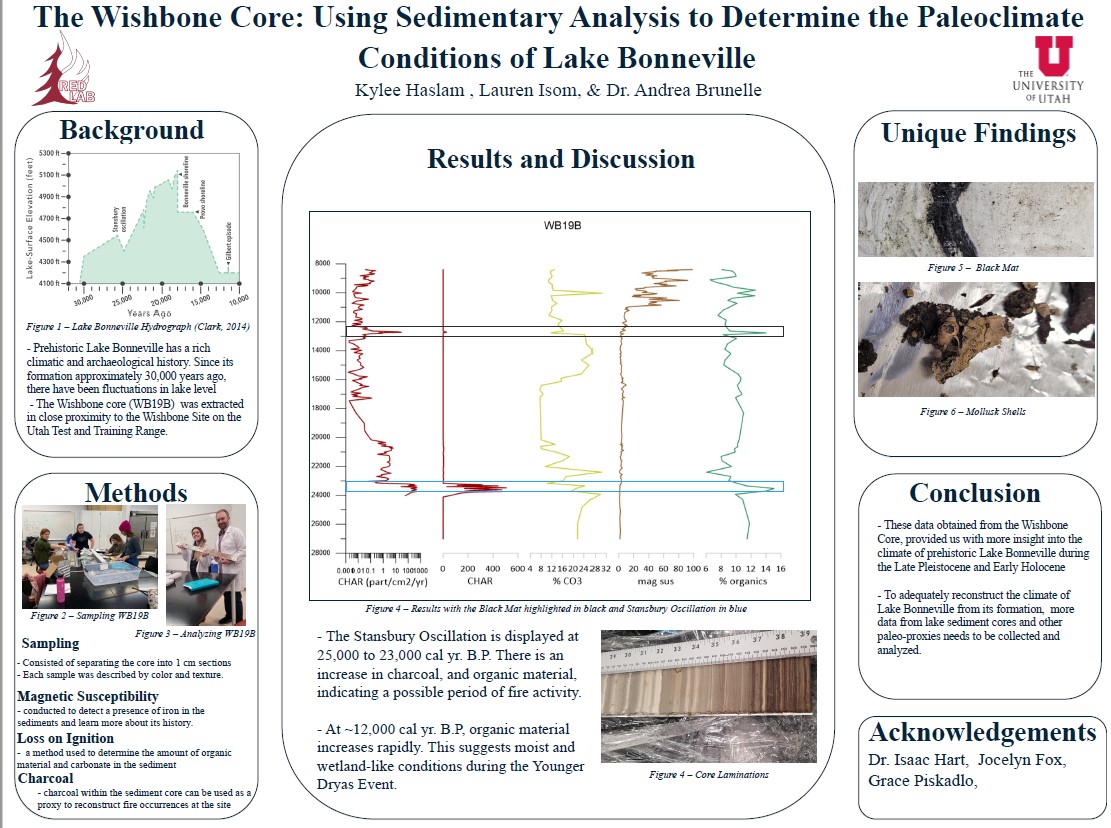
An Analysis of fire at the peak of the Aksumite Empire in Ethiopia
Miranda Clow, University of Utah, ENVST, NHMU (Dr.Mirchell Power, Geography, NHMU)
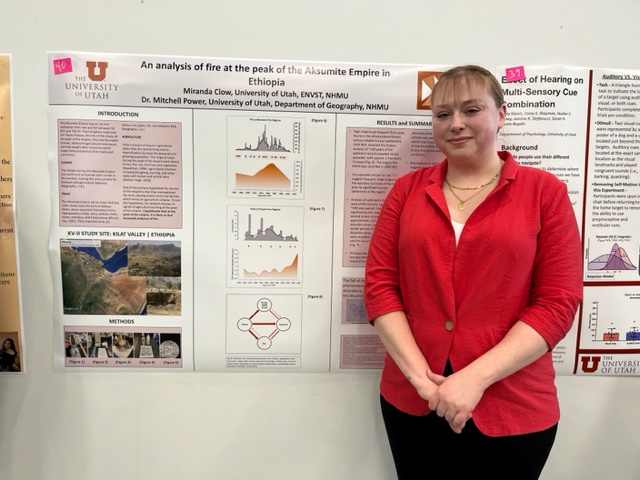
Firewood and Indigenous Ecological Knowledge on Cedar Mesa, UT
Anna HJohnson, Piper Christian, Sarah Buening, Kate Magargal
SPARC Environemtnal Justice Lab
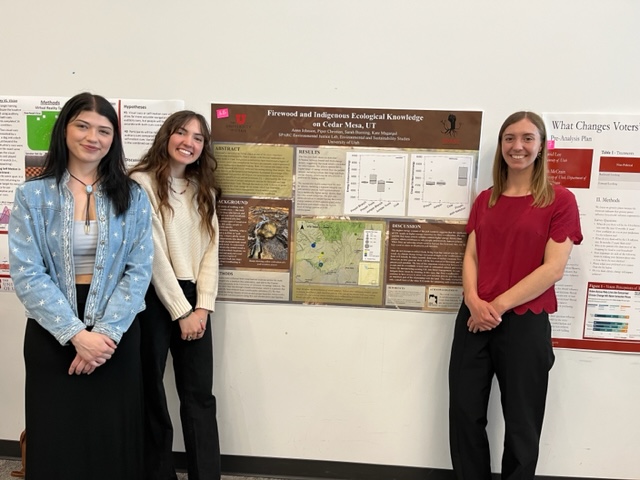
Examining free clinic patients household environmental safety and the resulting impact on their perceived stress levels
Claire Dinehart (Dr. Akiko Kamimura)
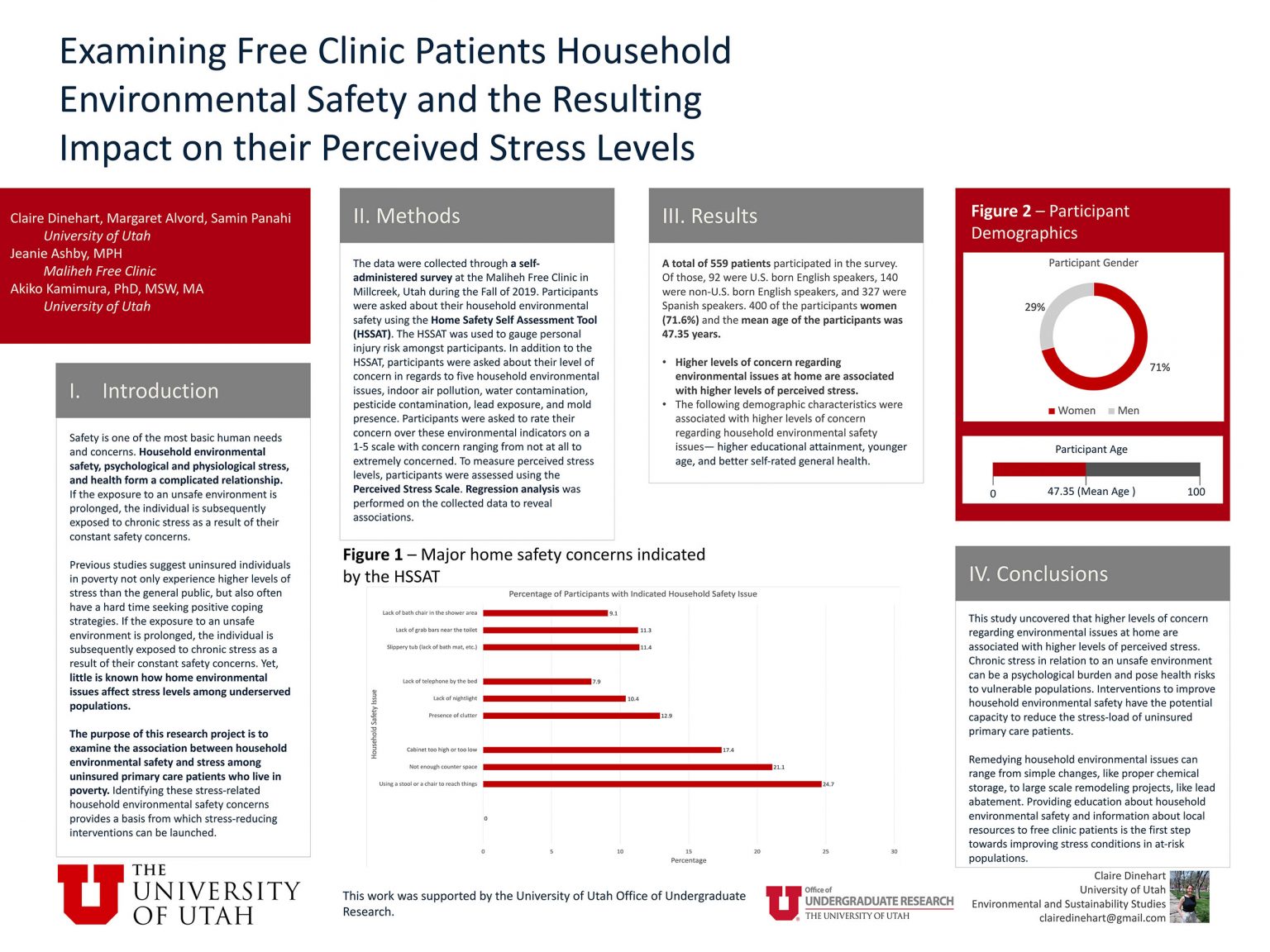
"The purpose of this research project is to examine the association between household environmental safety and stress among uninsured primary care patients who live in poverty. Identifying these stress-related household environmental safety concerns provides a basis from which stress-reducing interventions can be launched. Providing education about environmental safety and local resources is the first step towards improving stress conditions in at-risk populations."
Population-level genetics influences Populus fremontii success more than antecedent climate regime at Rio Mesa research garden
Sydney Boogaard (Dr. Jennifer Follstad Shah)
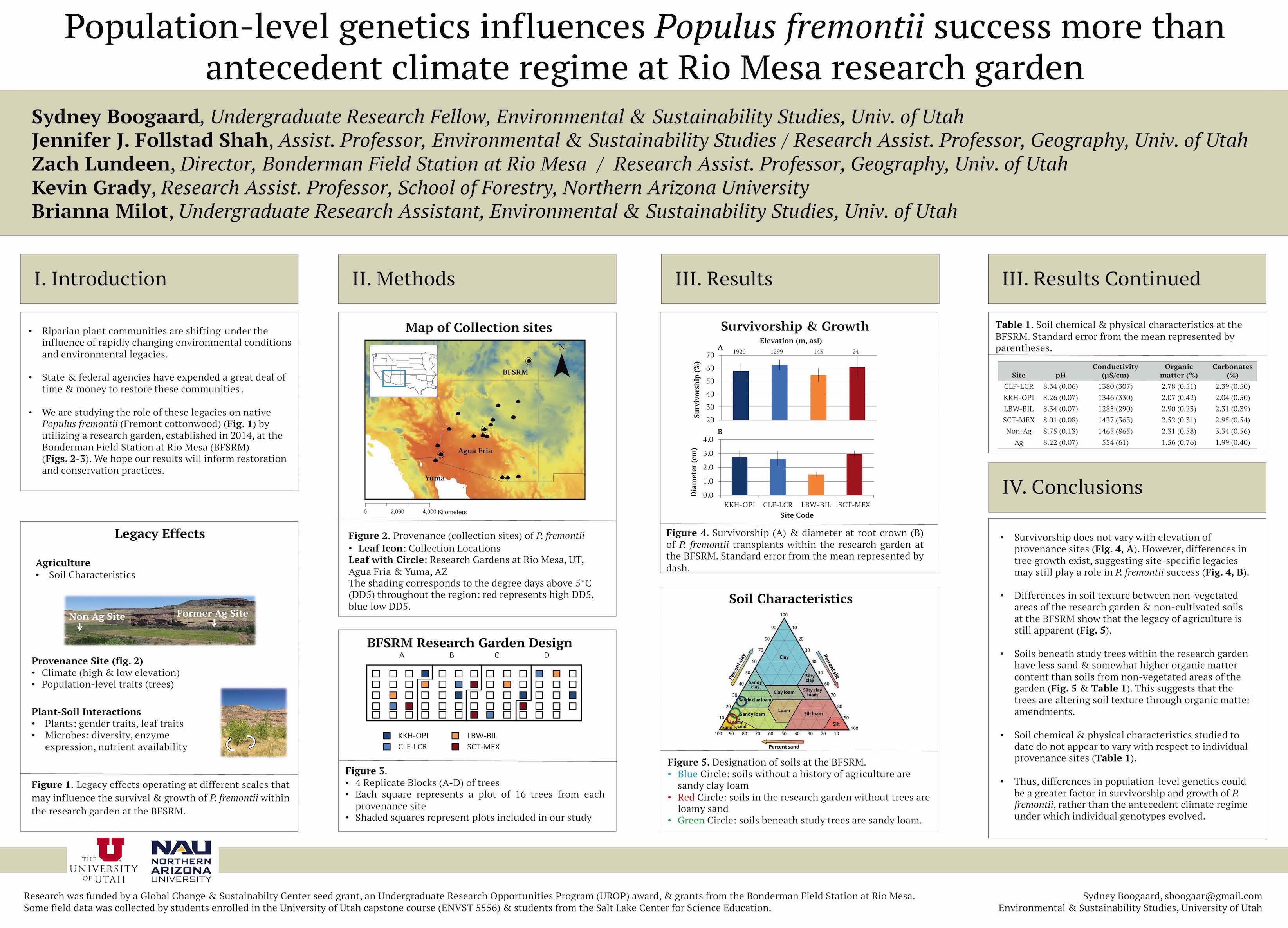
"Riparian plant communities are shifting under the influence of rapidly changing environmental conditions and environmental legacies. State and federal agencies have expended a great deal of time and money to restore these communities. We are studying the role of these legacies on native Populus fremontii by utilizing a research garden, established in 2014, at the Bonderman Field Station at Rio Mesa, UT. We hope our results will inform restoration and conservation practices."
Reconstructing paleoclimate variability in Baja California, Mexico through paleoecological analyses
Logan Hastings (Dr. Jennifer Watt)

"This is a paleoclimate reconstruction using paleoecological data from Baja California. Supplemental analysis of loss on ignition was additionally conducted to support final results."
The misogyny of climate denialism and its influence on world leaders' climate response
Uyen Hoang (Dr. Tabitha Benney)
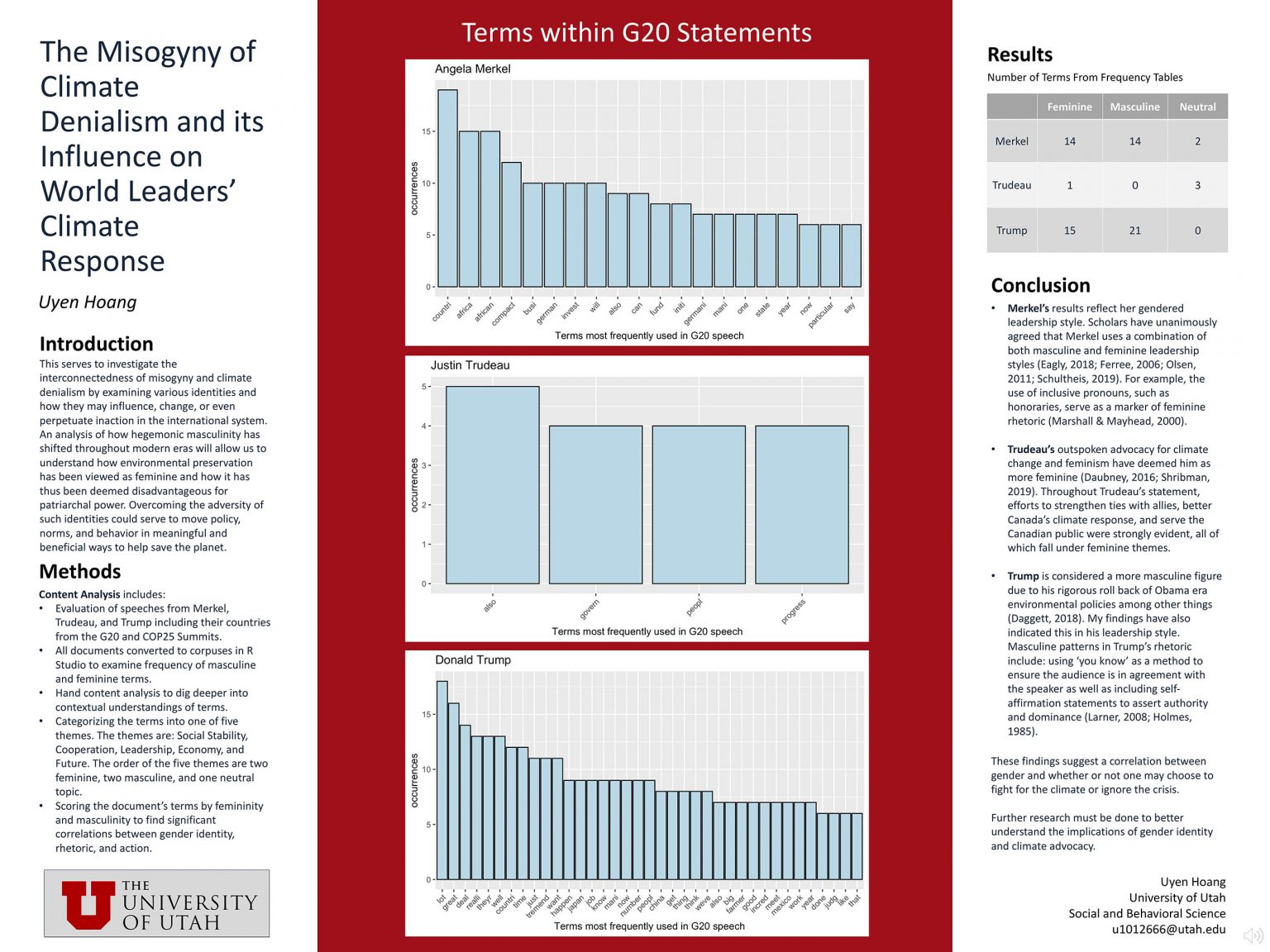
"My research serves to investigate the interconnectedness of misogyny and climate denialism by examining various identities and how they may influence, change, or even perpetuate inaction in the international system. By conducting a content analysis on three current world leaders, I hope to present a clearer understanding on how masculine identities in state leaders has evolved counter to public opinion and democratic norms to impact climate change policies and the future of the human race."
Treeline migration patterns of Pinus edulis throughout the Holocene
Claire Baer (Professor Larry Coats)

"The topic of this research was to investigate the arrival of a far-flung population of Colorado pinyon pine (Pinus edulis) in the Crawford Mountains located in Northeastern Utah. Using a reconstructive environmental proxy, Packrat (Neotoma) midden samples, we were able to identify macrofossils from past environments to radiocarbon date to get accurate emergence dates of this new species to the area."
Utahn's health risk perception surronding air pollution
Samuel Bey, Linda Derhak, & Zahra Saifee (Dr. Tabitha Benney)
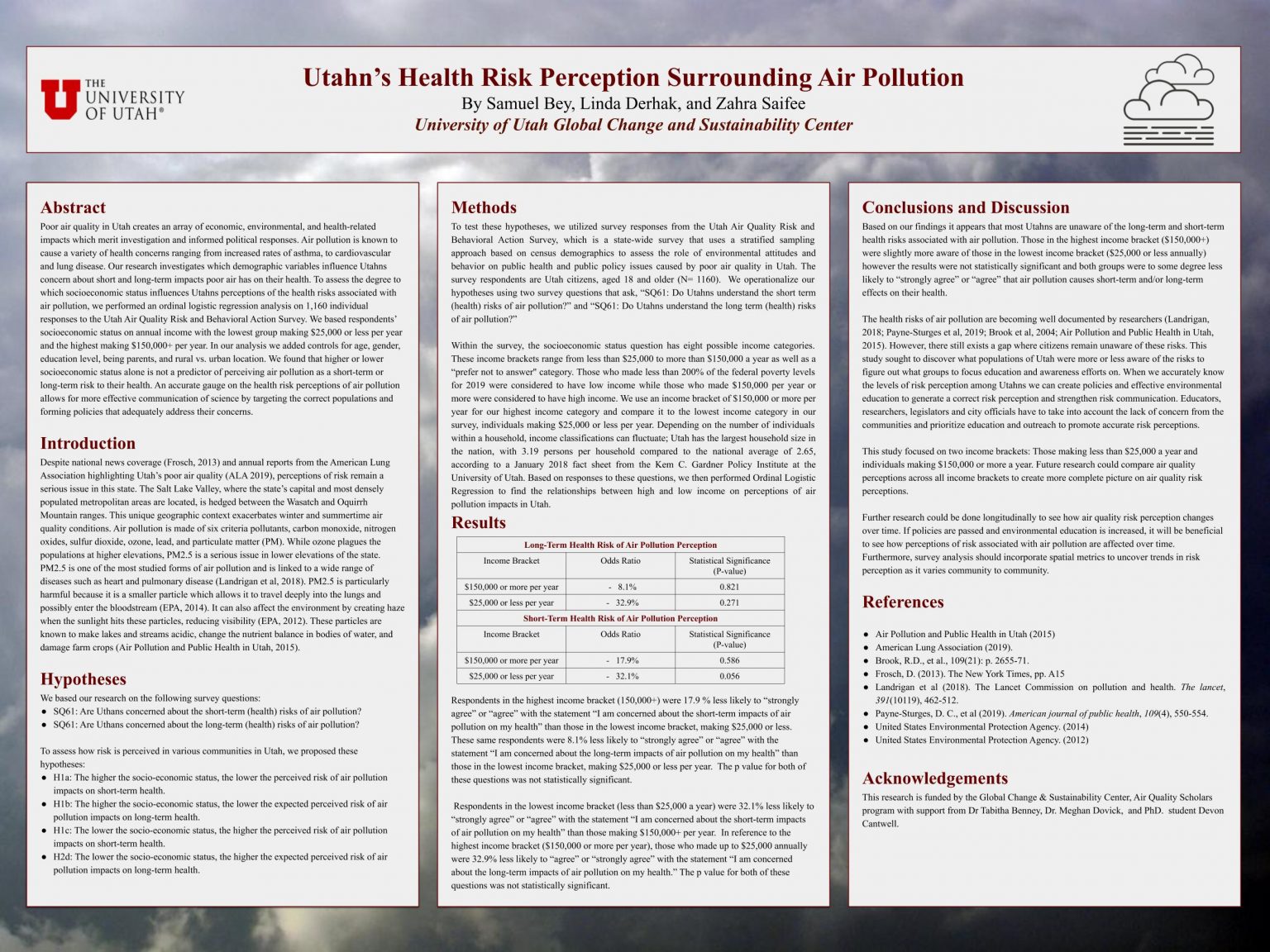
"This research project aims to understand Utahn’s perception of the short-term and long-term health risks of air pollution by looking at the perception differences among Utahn’s of high and low socioeconomic statuses. We utilized Dr. Tabitha Benney’s survey data of Utahn’s perceptions of air quality to test our hypotheses. This research will help inform policy, environmental education and awareness campaigns in the future."
A late-holocene fire record from the Sierra de San Pedro Martir National Park, Baja California, Mexico
Quinn Graves (Dr. Jennifer Watt)
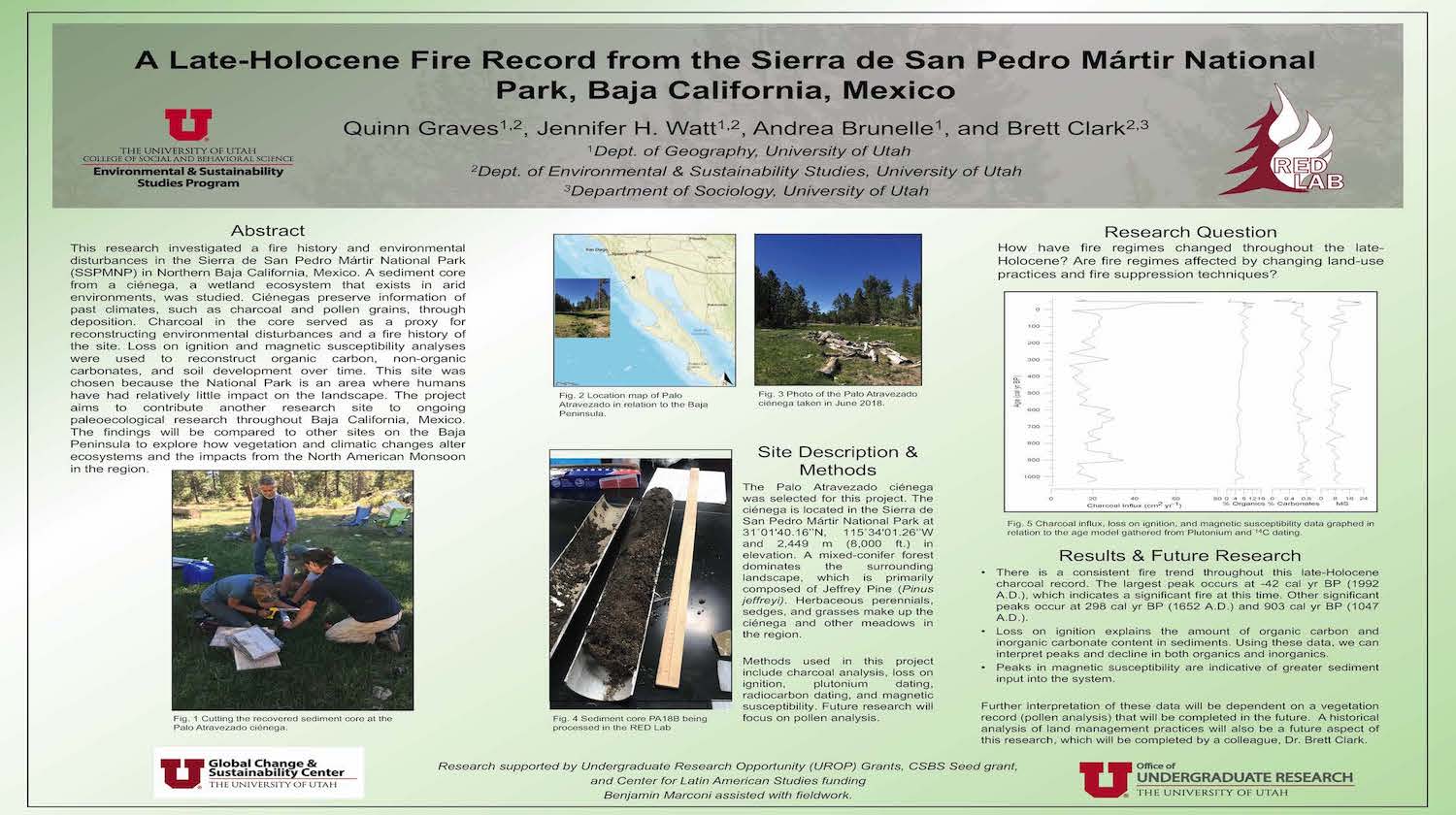
This project is a component of a larger body of research investigating past oscillations of the North American Monsoon (NAM) and its forcing on vegetation and fire regimes in North America. The findings will be compared with other sites on the Baja Peninsula to investigate how vegetation changes, climatic changes, and land-use changes alter ecosystems and the impacts from the NAM in the region.
Detangling the effects of temperature and nutrient availability on leaf litter decomposition
Jessica Gallafent (Dr. Jennifer Follstad Shah)
"The purpose of our project was to determine if there is a stream nutrient enrichment effect on the temperature sensitivity of leaf litter decomposition mediated by microbes and detritivores. Metabolic theory predicts an apparent temperature sensitivity of 0.65 eV for leaf litter decomposition; however, a recent study has found it to be much lower (0.34 eV) (Follstad Shah et al., 2017). Understanding how factors such as stream nutrient enrichment can influence temperature sensitivity will provide a greater understanding of how carbon cycling will be affected by rising temperatures."
Efficacy of volunteer weed pull programs on management of Myrtle Spurge (euphorbia Mrysinites) in the foothills of Salt Lake City, Utah
Brianna Milot (Dr. Jennifer Follstad Shah)
"This research evaluated the effectiveness of Urban Habitat’s efforts by identifying the frequency of Myrtle Spurge in the controlled area using point intercept transect surveys and quadrat analysis. I conducted the first set of surveys in Spring 2017 and the second in Spring of 2018 in order to provide an assessment of Urban Habitat’s weed removal efforts over multiple years of activity. Populations from both years reveals the abundance of Myrtle Spurge before and after 1, 2, and 3 years of weed pulls."
Isotopic analysis of the Jordan River nitrogen cycle
Michael Navidomskis (Dr. Jennifer Follstad Shah)
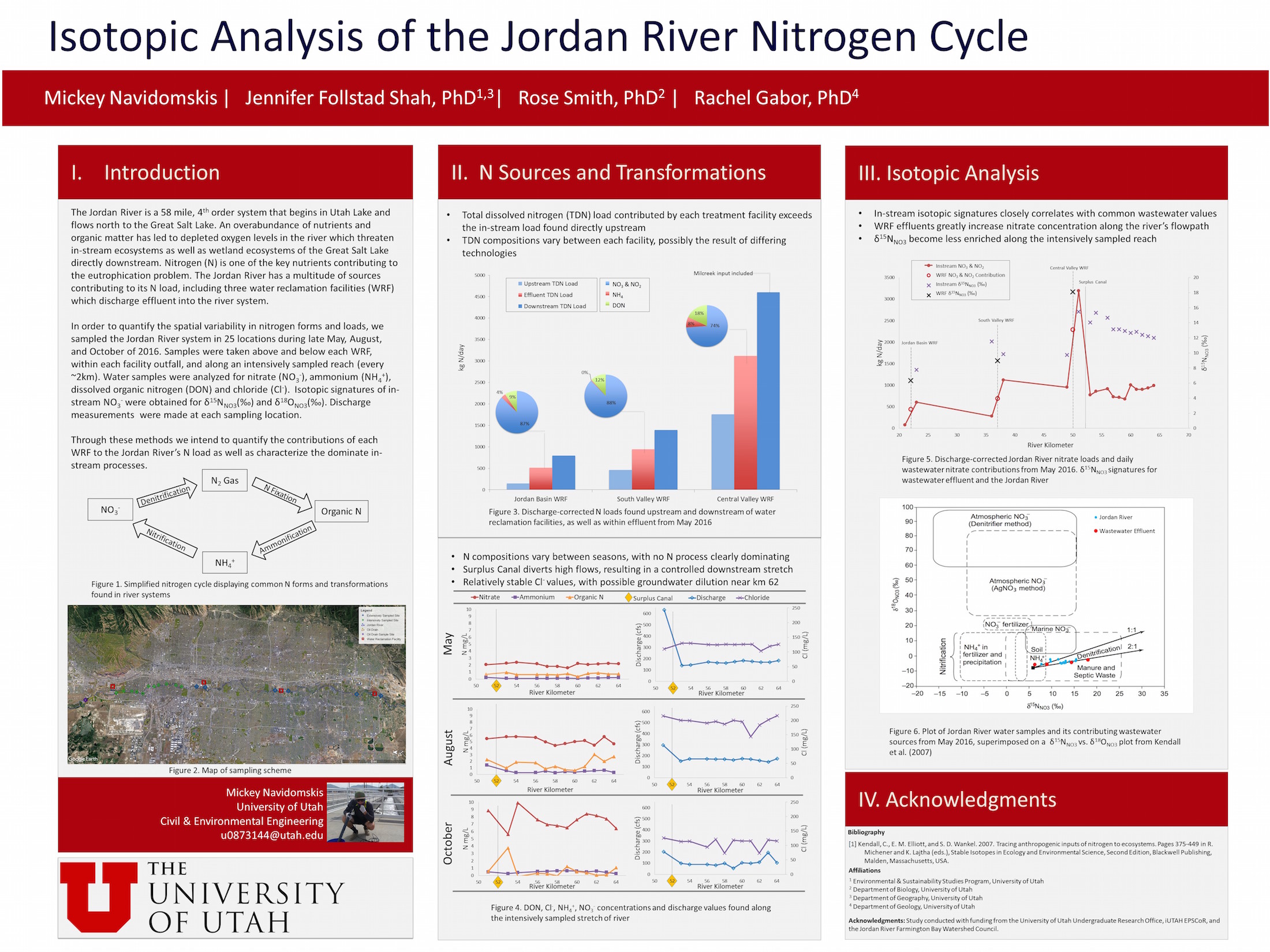
"The Jordan River is a eutrophic stream that begins in Utah Lake and flows north to the Great Salt Lake. An overabundance of nutrients and organic matter has lead to algae blooms and depleted oxygen levels in the river, which threaten in-stream ecosystems as well as the wetland ecosystems of the Great Salt Lake directly downstream. Among the nutrients involved in the eutrophication problem is nitrogen (N). The Jordan River has a multitude of sources contributing to its nitrogen load. Among these are four wastewater treatment plants, which discharge effluent into the river system. In order to quantify the spatial variability in nitrogen forms and loads, we sampled the Jordan River in 22 locations during late May and early August 2016 for dissolved, particulate, and sediment-bound nitrogen. This included an extensive survey of water and sediment sampling above and below each of four water reclamation facilities, effluent samples from each facility, and an intensively sampled (every ~2km) reach extending from downstream of the Surplus Canal to North 20th St. Early results have shown significant variation between the facilities’ contributions to the Jordan River and likely reflects the variability in technology utilized at each facility. While the average particulate organic matter concentration is much lower in the contributing effluents than the river itself (4.1 mg/L compared to 78.7 mg/L), water reclamation facilities are contributing significantly higher dissolved N concentrations than found in the river and may significantly increase N loading in the Jordan River. Data from one sampling date in late-May shows that the river just upstream of the Surplus Canal diversion had an approximate N load of 4.6 metric tons N per day, while three upstream treatment facilities (plus Millcreek in conjunction with one effluent outfall) have combined for an approximate load of 4.42 metric tons N per day, suggesting a significant portion of the Jordan’s nitrogen load is derived from wastewater. Early results from the intensive sample region have shown increasing NH4+ concentrations trending along the flowpath, although TDN does not increase substantially over the same stretch. Forthcoming isotope analysis will offer more insight into the sources and predominant N processes along the Jordan River and will enhance our understanding of wastewater impacts."
Reconstructing a fire history record and disturbance patterns for a high elevation site in the Northern Rocky Mountains
Jordin Hartley (Dr. Jennifer Watt)
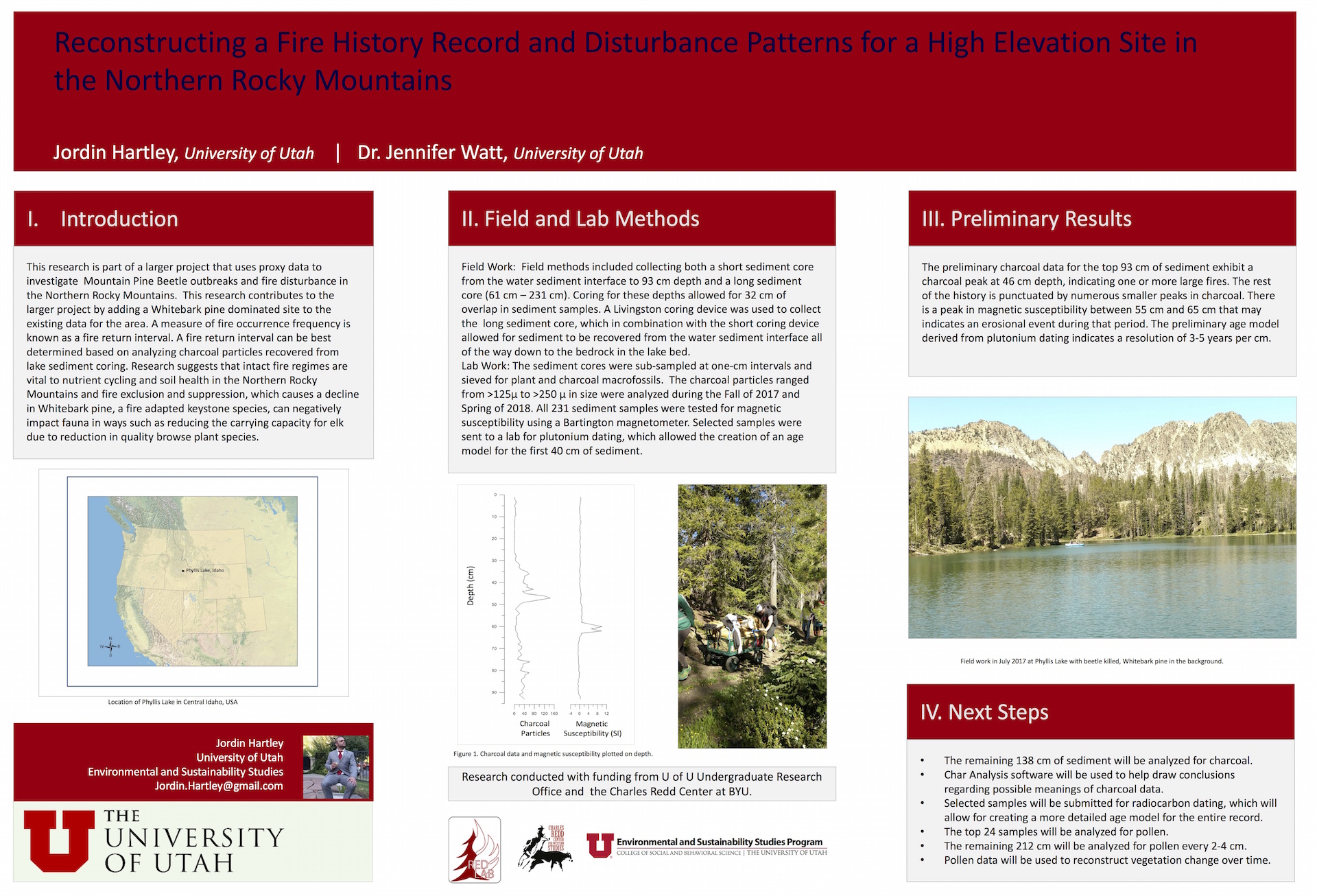
"This research is part of a larger project that uses proxy data to investigate Mountain Pine Beetle outbreaks and fire disturbance in the Northern Rocky Mountains. This research contributes to the larger project by adding a Whitebark pine dominated site to the existing data for the area. A measure of fire occurrence frequency is known as a fire return interval. A fire return interval can be best determined based on analyzing charcoal particles recovered from lake sediment coring. Research suggests that intact fire regimes are vital to nutrient cycling and soil health in the Northern Rocky Mountains. Fire exclusion and suppression, which cause a decline in Whitebark pine, a fire adapted keystone species, can negatively impact fauna in ways such as reducing the carrying capacity for elk due to reduction in quality browse plant species."
Possible benefits of ectomycorrhizal infection of conifer seedlings at Alta Ski area
Anna Albertson (Dr. Jennifer Follstad Shah & Dr. Jennifer Watt)
"The University of Utah Environmental and Sustainability Studies Program and DIGIT Lab have partnered with Alta Environmental Center since 2013 to implement a student service project. In this project, students enrolled in Field Experience: Environmental and Sustainability Studies to help maintain tree cover on steep slopes at Alta Ski Resort by collecting and sowing seeds from local conifers in the Alta plant nursery and later planting the seedlings in areas designated for reforestation. In summer 2016, we analyzed the survival and growth of conifer seedlings planted between 2013-2015. We found that, on average, 11% of conifer seedlings survived since planting and grew between 1-2.5 centimeters per year."
Vegetation reconstruction of the British Virgin Islands
Cassandra Nicole Oliveira (Dr. Mitchell Power)
"The British Virgin Islands have historically experienced fluctuating intensities and multiple types of disturbance that have altered the landscape dramatically, such as hurricanes and human impacts. The storm surges and high winds can level vegetation and allow colonization of new plant species while depositing pollen and other plant material into water bodies. Humans have a history of cultivation and burning on these islands leading to clearing of land for crops and introducing foreign species. Both pollen and charcoal can be collected to tell a story of activity in this region. Coastal salt pond sediments represent an archive of island ecological change throughout history. Through pollen analysis from sediment cores the past vegetative makeup and change can be investigated. Three types of vegetative damage from tropical cyclones are defoliation (most common), snapping, and uprooting (Walker, 1991). While tropical cyclones are severe, mortality amongst trees are low and once refoliated, spread seed and often show increased diameter (Walker, 1991)."
Impact of cattle grazing on Great Salt Lake wetland ecosystems invaded by phragmites Australis
Jay Christian Jensen (Dr. Jennifer Follstad Shah)

"Phragmites australis (phragmites) is a highly invasive, resilient plant that has made its home in many parts of the United States. It has an ability to grow under a variety of conditions and can reproduce sexually (through pollination and dispersal of seed) and vegetatively (through propagation of rhizomes). In wetland areas, these plants thrive off of the abundance of water and nutrients, often outcompeting native plant species that are important to the native animals of that area. Management of these plants is very important, though there have been few successful methods of controlling them through herbicides, burning, mowing or trampling. Grazing, however, has a good potential for eradicating these plants with possible recovery of native plants, especially on Utah’s Great Salt Lake wetland area where fires are not a possibility and herbicides could pose a threat by being applied in an ecosystem where they could accumulate in water. In this study, cattle were placed onto experimentally grazed one-acre plots, which were located in proximity to the ungrazed control plots at three areas: Farmington Bay, Harold Crane Water Management Area (WMA; 2 sites), and Howard Slough Waterfowl Management Area (two sites). We asked three questions: 1) What is the effect of grazing on phragmites growth? And how will grazing affect the cover of Phragmites and their size? 2) Is there a clear chemical signature of grazing? 3) What is the effect of grazing on nitrogen (N) concentrations in water? We measured plant cover and stem height at all study sites. We collected manure, soil, phragmites leaves, and water samples within grazed and ungrazed wetland plots at a subset of sites to determine isotopic composition (13C, 15N), with the expectation that manure would be enriched in 15N (δ15N ~ 15). We measured NO3-N and NH4-N concentrations in three water sources (well, flood, and pond water) at Farmington Bay. Pond water was the source of flood water inundating sites. Preliminary results show that grazing may be effective at controlling phragmites growth. However, we did not see a clear chemical signature of grazing. Water chemistry results were mixed. We saw no effect of grazing on flood water inorganic N content, but elevated NH4-N concentrations in well water at grazed sites after cattle have been introduced. "
Low cost air quality sensor development & testing
Alexandre Veilleux & Luis Vidal (Dr. Jennifer Follstad Shah)
"Salt Lake City has a unique geography. Thermal inversions, which trap pollution (mainly particulate matter < 2.5 um) occur in winter months. In summer, heat and sunlight react with volatile organic compounds and nitrous oxides to form photochemical smog, which includes ozone and secondary pollutants. We aim to test the accuracy of a low-cost, “Do-It-Yourself” (DIY) air quality sensor in relation to existing high-tech sensors. If accurate, many DIY sensors could be deployed over a larger area than presently studied, thus improving the spatial resolution of air quality data collection. The affordability of DIY sensors also allows for potential applications not feasible with expensive analyzers, such as education, citizen science, and science-based advocacy."
Historic records of mountain pine beetle outbreaks at Hoodoo Lake, Idaho
Carlie Teague (Dr. Jennifer Watt)

"Description Under Construction"
Yampa sediment analysis and anthropogenic influences at Red Fish Bog
Victoria Simmons (Dr. Andrea Brunelle)

"Description Under Construction"
Holocene records of mountain pine beetle outbreaks in the northern rockies
Kelsey Howard (Dr. Andrea Brunelle & Dr. Jennifer Watt)
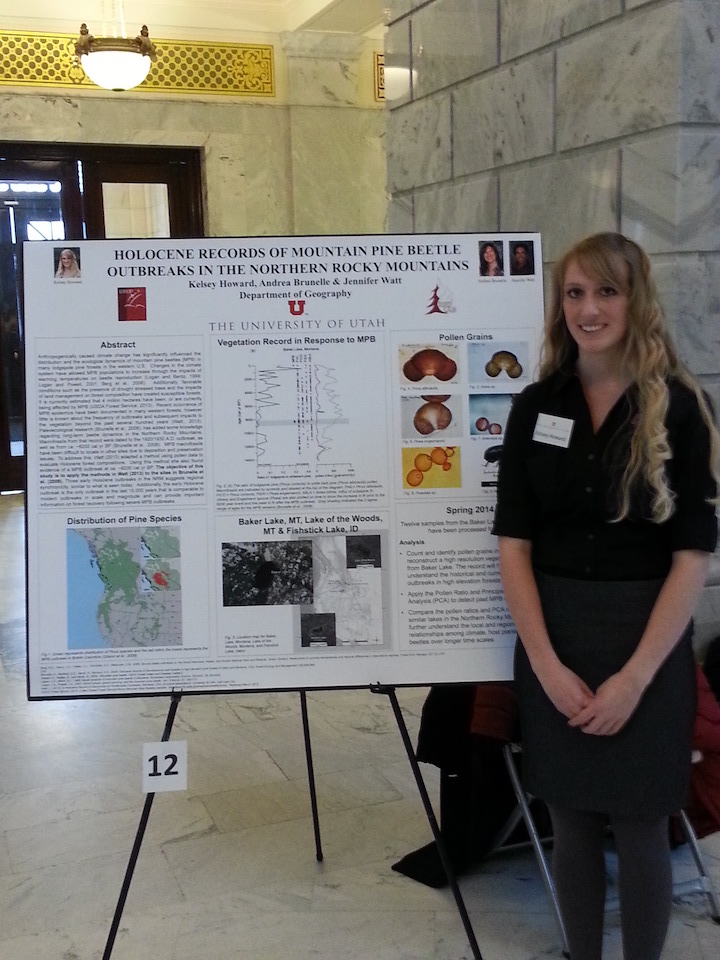
"Anthropogenically caused climate change has significantly influenced the distribution and the ecological dynamics of mountain pine beetles (MPB) in many lodgepole pine forests in the western U.S. Changes in the climate system have allowed MPB populations to increase through the impacts of warming temperatures on beetle reproduction (Logan and Bentz, 1999; Logan and Powell, 2001; Berg et al., 2006). Additionally, favorable conditions such as the presence of drought stressed trees and the impacts of land management on forest composition have created susceptible forests. It is currently estimated that 4 million hectares have been, or are currently being affected by MPB (USDA Forest Service, 2013). Recent occurrence of MPB epidemics have been documented in many western forests, however little is known about the frequency of outbreaks and subsequent impacts to the vegetation beyond the past several hundred years (Watt., 2013). Paleoecological research (Brunelle et al., 2008), has added some knowledge regarding long-term beetle dynamics in the Northern Rocky Mountains. Macrofossils from that record were dated to the 1920/1930 A.D. outbreak, as well as from ca. ~8200 cal yr BP (Brunelle et al., 2008). MPB macrofossils have been difficult to locate in other sites due to deposition and preservation issues. To address this, Watt (2013) adapted a method using pollen data to evaluate Holocene forest compositions. Using this method she also found evidence of a MPB outbreak at ca. ~8200 cal yr BP. The objective of this study is to apply the methods in Watt (2013) to the sites in Brunelle et al. (2008). Three early Holocene outbreaks in the NRM suggests regional synchronicity, similar to what is seen today. Additionally, the early Holocene outbreak is the only outbreak in the last 15,000 years that is comparable to modern outbreaks in scale and magnitude and can provide important information on forest recovery following severe MPB outbreaks."
Implications of land use on rural community resilience and national security
Maximilian Stiefel (Dr. Jennifer Watt)

"This project studies the impacts of sugarcane cultivation on rural community resilience in municipios throughout Brazil. Whether sugarcane cultivation has generated vulnerabilities, such as population diffusion, ecological transformation, and adverse path dependencies, for rural community resilience is the primary focus. Resilience is critical in that it demonstrates adaptation efficacy for a community facing shifting capabilities. Social cohesion and capital also tie into how resilience correlates to meaningful interactions among individuals. Over the past thirty years Brazil became second to the U.S. in terms of global ethanol production, generating robust economic growth. However, sugarcane cultivation expansion has forced some cattle ranchers from southern Brazil to migrate north, resulting in the clearing of Amazon forestland for grazing. Pastureland displacement from sugarcane cultivation generates various concerns for rural economies, social cohesion, and socioeconomic class disparities. There currently lacks abundant examination of impacts to rural communities adjacent to sugarcane ethanol cultivation and production. I formulate a regression analysis to gauge shifts in resilience from sugarcane cultivation that will include a variety of metrics such as employment rates, livelihood diversification, and educational attainment. From this information I will suggest practices that afford a more resilient economic, agricultural, and social model for rural communities. The suggestions I put forth will not be palliative, but will instead be consistent with sustainable practices that foster capabilities, socioeconomic equality, and environmental stewardship. Resilient rural community development models avoid historic deforestation patterns and aid climate change mitigation, which in turn safeguards Brazil’s myriad economic sectors. Robust rural economies support national security by ensuring a healthy agricultural sector, avoiding unsustainable urban migration, and reducing poverty. The models and practices I suggest will inform policies and programs for Brazilian officials, agriculturalists, and conservationists to support rural communities, mitigate the impacts of climate change, and increase national security."
Paleoecological analysis of the amazon river basin of Bolivia
Mary McIntyre ( Dr. Mitchell Power)
"The Amazon River Basin is comprised of over 11 biomes and is home to the greatest plant and animal biodiversity in the world. Amazon ecosystems play a significant role in the global carbon cycle acting as the largest terrestrial carbon sink. Long-term paleoecological studies can provide a better understanding of how these crucial ecosystems respond to climatic variability on centennial to millennial scales. The purpose of this research is to compile data about ecosystem response to past disturbances in order to understand how the region may respond to future changes."
